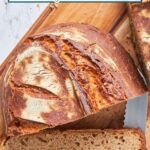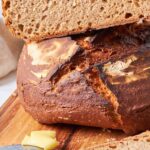Description
Ready to bake a delicious, authentic German rye bread with a secret healthy twist? This recipe for German Sourdough Protein Rye Bread (or Krustenbrot) combines the traditional, earthy flavors and hearty, crusty texture you’d find in a German bakery with an incredible boost of protein, perfect for keeping you full and energized. Whether you’re a seasoned baker or just starting your sourdough journey, this loaf is surprisingly easy to make and tastes just like the real deal.
Ingredients
The Starter
- 25g ripe, existing starter
- 50g rye flour
- 50g water
The Dough
- 425g strong white flour
- 200g rye flour
- 50g rolled oats
- 100g sourdough starter
- 180g cottage Cheese
- 50g whey protein powder,unflavored
- 300ml water
- 1 tbsp malt extract (or honey)
- 2 tbsp olive oil
- 2 tsp kosher salt
Instructions
2 days before you plan to bake your bread (or the morning before, if your kitchen is very warm)
Prepare your active starter (levain)
- Take 25g of your existing sourdough starter. Add 50g rye flour and 50g filtered water (or good quality drinking water). Add a tablespoon more water if the 50g aren’t enough to wet all the flour. Rye can vary wildly in absorption.
- Your starter should become fairly hard to stir while mixing and end up as very stiff, heavy sort of pancake/warm peanut butter consistency. If in doubt, rather go too firm than too liquid, as a very soft starter doesn’t have enough rising powder for rye bread.
- Leave it in a lightly covered container on your kitchen counter until the next day. If your kitchen is particularly warm, especially in summer, preparing it the morning about four hours before mixing the dough might be best.
1 day before baking
Blend the wet ingredients
- In the afternoon start by blending the cottage cheese with some of the water and the protein powder until smooth.
- Using a dough whisk, stir in the remaining water and 100g of the sourdough starter.
- You could probably blend it, but I’m trying to be respectful of the little sourdough bacteria and treat them gently. Not everyone appreciates the wild ride in a blender!
- Keep the remaining 25g of the starter for your next bread. You can keep it in the fridge, and it’ll last for at least a week.
Mix the dry ingredients
- In a large bowl stir together both of the flours and salt. I’m using kosher salt, which has a higher volume per gram, so for me this is 2 tsp. If you are using sea salt, use 1 tsp.
- Stir the wet into the dry ingredients using your dough whisk or spoon, make a little well in the middle of your flour then pour in your wet ingredient blend, stirring as you go. Mix until no dry flour patches remain.
- The dough will be very sticky and lumpy at this point, that’s totally fine.
- Leave it to rest for 30 minutes to 1h for the autolyse, allowing the flour to hydrate.
Stretch and Folds: Building Structure (Optional but Recommended)
- This part, while flexible and not absolutely crucial to making decent bread, helps developing the gluten rapidly during the bulk ferment, gives the dough structure and helps trapping air inside for those large bubbles you keep seeing in the pictures of sourdough bread. I also find it very satisfying.
- I have left it out when making for example my German Rye Beer bread, which has a similar high rye flour content, but a wetter dough and won’t be as bubbly even if I kept stretching and folding all day long. But for this bread I usually do it, as I see the difference right away.
How To Do Stretch And Folds
- Wet your hands. This will mostly prevent the sticky dough fingers. Contrary to flour, which makes them worse.
- Push both hands under the dough and lift one side up. Stretch it until nearly the whole dough is lifted out of the bowl, then fold it over itself. Turn the bowl by 90 degrees and repeat. Do this 4 times, until the bowl has turned back full circle. Cover.
- The pictures above are the results right after the first stretch and fold. You can see how fast this develops the gluten structure.
- Repeat the process 2-3 more times after 30 minutes each, until you feel the dough is much smoother, easier to handle and shapes into a neat (if wobbly) loaf. After the last stretch and fold, either shape or cover and leave to ferment overnight in the fridge.
Shape Your Loaf
- You can do this the evening before baking. If you do shape on the day of baking, your dough will need another two or three hours of resting to puff up again.
- On a floured surface, tip your dough out of the bowl.
- Gently stretch it into a rough rectangle, then fold the sides into the middle, overlapping like an envelope. Rotate the dough and fold in the other two ends so they meet in the middle, pinching the dough slightly in the middle, until you feel a good surface tension and it looks relatively oval.
- Add a little more flour, then turn around and push the dough underneath itself with either the side of your hand or a bench scraper, until you have a pretty smooth oval shape.
- Of course you can also create a round boule shape for this bread. I just happen to love the classic oval for this loaf.
- Flour your banneton or bowl well and flip your dough ball upside down inside. Cover with a very damp kitchen towel or a shower cap and store in the fridge overnight for the cold ferment.
- Or, if you decided to shape it in the morning before baking, allow to rise, covered, for another two or three hours.
Bake Your Protein Sourdough Bread
Pre-heat Oven
- With the Dutch oven inside, pre-heat your oven to 475°F/245°C for 30 minutes to 1h.
- Even if it shows as pre-heated after a shorter time, the longer time is needed to reach the optimal temperature.
Score Your Bread
- While the oven heats up, carefully tip your dough onto the center of the prepared baking parchment. If necessary, gently push it back into shape. Sprinkle the top with a little flour, then, using a lame or a sharp knife, score your bread.
- You can get as creative or simple as you like.
- For the perfect scoring patterns you see online, you can freeze your bread for 10-20 minutes, which hardens the surface and makes precise scoring much easier. I admit I usually don’t bother.
- One long score, about 1cm deep, at about a 45-degree angle slightly towards the side of the bread gives you the “classic” opening flap when the bread rises in the oven. Without scoring it would just break wherever it wants under the surface tension and might not rise as high. So one score is a good idea. Anything else is decoration.
Now it’s time to bake:
- Using oven gloves, remove your pot from the oven onto a heat proof surface. Take off the lid.
- Be mindful where you put this. I managed to burn a dark ring into a wooden chopping board. Ever since I put it either directly on my hob or a baking tray.
- Using the edges of the baking parchment, carefully lower your loaf into the Dutch oven. Close the lid and put it back into the oven.
- Immediately lower the temperature to 425°F/220°C and bake for 30 minutes.
- After that time take off the lid and bake for 15-20 minutes longer or until deep caramel brown with darker edges on the scored parts, where it puffed up.
- Usually it is baked through at this point, but you can tap the bottom to check: If it sounds hollow your bread is ready. If not, bake for a few minutes longer.
Cool
- Remove the bread from the oven. You can allow it to rest for about 20-30 minutes inside the Dutch oven. After that transfer to a cooling rack to avoid condensation and soggy crust.
Now comes the hard part. I know this smells really, really good and you want a slice right now!
But be patient. Leave to cool for at least 2 hours, to get a nice clean cut.
Notes
For those used to white sourdough bread:
Rye sourdough is much firmer. Don’t be tempted to add lots of water to get the typical “jiggly” texture.
How To Store
Homemade sourdough bread is incredibly meal prep friendly:
- You can prepare it the day before and just push it into the oven in the morning or 3 hours before you’d like to eat it. Or prepare the dough up to 3 days in advance and leave it in the fridge. The sourdough flavor will get more pronounced the longer it ferments.
- This bread keeps well in a bread tin for about 3 days or up to 5 in the fridge.
- It freezes perfectly for up to 6 months and is excellent toasted.
- Prep Time: 30 minutes
- Cook Time: 1 hour
- Category: Protein Sourdough
- Method: Bake
- Cuisine: German





